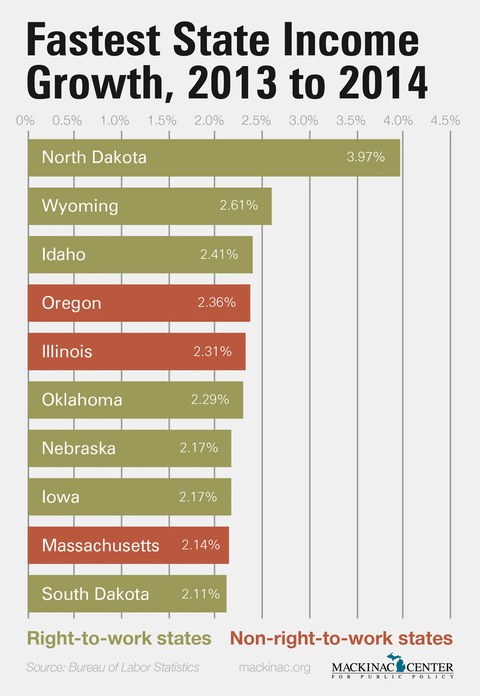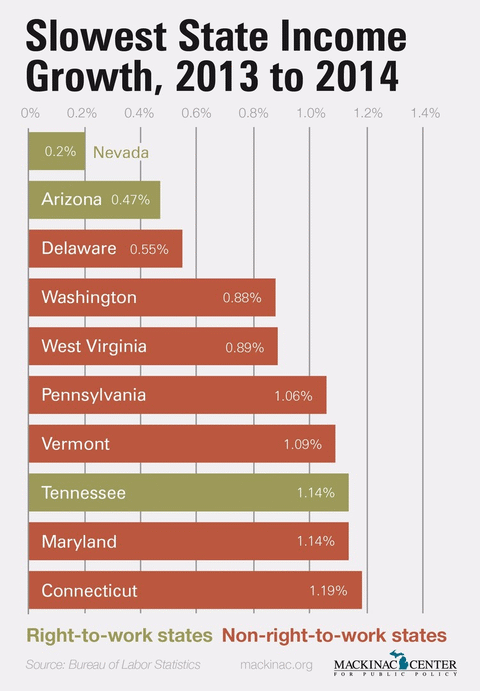Right-to-Work States Have Faster Income Growth
Last year, seven of the 10 states with greatest increase in income were right-to-work
Opponents of right-to-work insist the policy causes wages to plunge, but federal data suggest the opposite is true.
Including Michigan, there are 25 states with right-to-work laws ensuring no worker can be required to pay a union as a condition of employment. In many right-to-work states, wages and incomes are growing faster than in forced unionization states.
Seven of the 10 states with the fastest wage growth from 2013 to 2014 (the latest year data was available) were right-to-work states. Those 10 states and their wage growth rates were: North Dakota: 3.97%, Wyoming: 2.61%, Idaho: 2.41%, Oregon: 2.36%, Illinois: 2.31%, Oklahoma: 2.29%, Nebraska: 2.17%, Iowa: 2.17%, Massachusetts: 2.14% and South Dakota: 2.11%.
North Dakota, Wyoming, Idaho, Oklahoma, Nebraska, Iowa, and South Dakota are right-to-work states.
Right-to-work took effect in Michigan in March 2013, and the average wage in Michigan grew from 2013-14. After Indiana’s right-to-work law was implemented in March 2012, Indiana’s average wage increased from 2012-13 and again from 2013-14.
From 2013-14, seven of the 10 states with the slowest wage growth were forced unionization states. Those states and their wage growth were: Nevada: 0.20%, Arizona: 0.47%, Delaware: 0.55%, Washington: 0.88%, West Virginia: 0.89%, Pennsylvania: 1.06%, Vermont: 1.09%, Tennessee: 1.14%, Maryland: 1.14% and Connecticut: 1.19%.
Delaware, Washington, West Virginia, Pennsylvania, Vermont, Maryland, and Connecticut are forced unionization states.
These figures, based on the latest available hourly wages for all occupations from the U.S. Bureau of Labor Statistics, are not adjusted for the cost of living in each state. According to 2013 estimates from the U.S. Bureau of Economic Analysis, the 10 most expensive states to live in are all forced unionization states.
Using BEA’s latest available Regional Price Parities calculations, the states with the lowest cost of living adjusted wages in 2013 were Hawaii and Montana. Hawaii and Montana are both forced unionization states.
Like wages, per capita disposable personal incomes — which are calculated by the BEA with adjustments for each state’s tax burden — often grow faster in right-to-work states than in forced unionization states.
Without accounting for the varying cost of food, housing, gas, or other items, per capita disposable personal income went up in every state from 2013-14. Nine of the 12 states where per capita disposable personal incomes grew from 2012-13 were right-to-work states.
An analysis of household income growth for the past 25 years shows that right-to-work states average significantly faster growth.
Michigan Capitol Confidential is the news source produced by the Mackinac Center for Public Policy. Michigan Capitol Confidential reports with a free-market news perspective.




 Right-to-work no longer rules in private sector
Right-to-work no longer rules in private sector
 Hydra-Lock employees vote to decertify their union
Hydra-Lock employees vote to decertify their union
 Right-to-Work law repeal more than doubles federal complaints
Right-to-Work law repeal more than doubles federal complaints